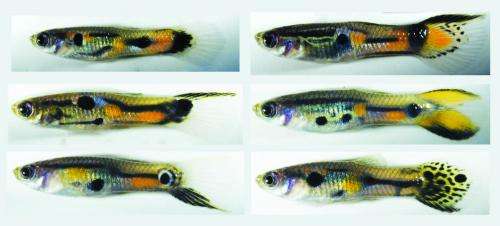Male guppies with the rarest colour patterns preferred by females

(Phys.org) —New research shows that the rarer a male guppy's colour pattern, the more attractive he is to females and the more offspring he will father.
"We think that females might exhibit this preference because it helps them to avoid mating with close relatives," said Helen Rodd of the Department of Ecology & Evolutionary Biology. "Guppies breed in small pools that are isolated from other pools in their stream and so often live surrounded by their fathers, uncles, brothers, and cousins. By picking a male that is quite distinct from the rest, a female could be trying to increase the chance that he isn't related to her."
The researchers looked into this mate preference behaviour to explain the wide variety of colours and patterns in natural populations of fish. The bodies and tails of male guppies in the wild are covered with spots and stripes of many different colours: orange, yellow, blue, violet, green, black and white. The sizes and positions of the spots also vary from one individual to the next. "We think this variety exists because when females prefer unusual-looking males, these rare males will leave many sons and grandsons and slowly his, and his descendant's, colour pattern will become more common. But when this colour pattern becomes common those that have it will leave fewer offspring and so that colour morph will gradually decline in prevalence. We will expect a cycling of a colour morphs."
Rodd says the phenomenon is a bit like fashions from earlier decades that get recycled over time. "Say, a small group of hipsters in Greenwich, New York City or San Francisco decide to dress like people from the 1970s, then a few fashion designers see them and think, 'Hey, that's cool,' and spread the message that it is cool to dress this way. Eventually lots of people will be dressing this same way and it won't be novel anymore and it will fall out of fashion, until a decade later when another group of fashion-conscious individuals reinvent 70s fashion again."
"This fish situation is similar except, in this study, we showed this faddish behaviour in female fish actually translates into males' success with females and thus their ability to pass their genes to the next generation. New 'fashions' appear as new colour combinations arise and eventually the equilibrium that we see today with many, many different colour patterns has been reached. It is like living in a big city—we see a whole range of styles, including goth."
Over time, the female guppy preference for males with unusual colour patterns, and the invention of new colour morphs and the recycling of old colour morphs should create the incredible array of colour that we see in these fish, Rodd explained.
The research team conducted their experiments in the guppy's natural habitat—little pools in streams in Trinidad. They caught all of the male and female guppies from four to six pools and sorted them into two types—those with a lot of colour on their tail fin or those with very little colour in their tail fin. In their experimental manipulation, they place the males in the pools so that, in some pools, 75 per cent of the males had a lot of colour on their tails and 25 per cent of the males had little colour on the tails. They used the opposite ratio in other pools. They gave the females a tiny tattoo to identify which pool they were from and put them back in their own pool.
After 16 or 17 days, they collected the females, took them to the lab, raised their offspring and figured out which male was the father of each of the offspring. They repeated this experiment in three different streams, in four to six pools each time. Females consistently preferred the males that were rarer.
More information: The paper, entitled 'Mating advantage for rare males in wild guppy populations' will appear in Nature on October 31. dx.doi.org/10.1038/nature12717
Journal information: Nature
Provided by University of Toronto




















